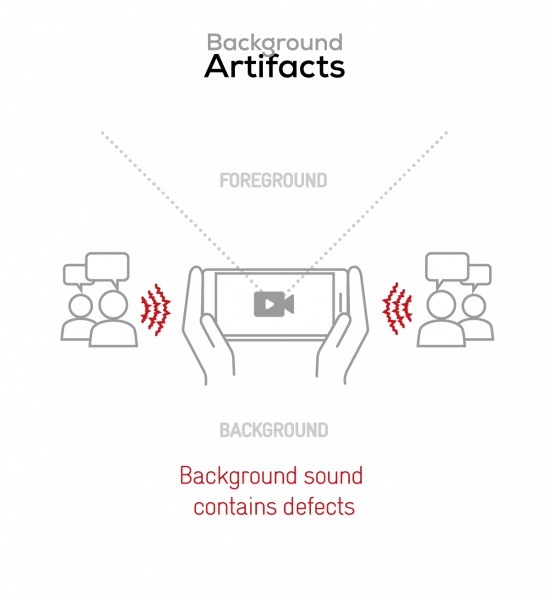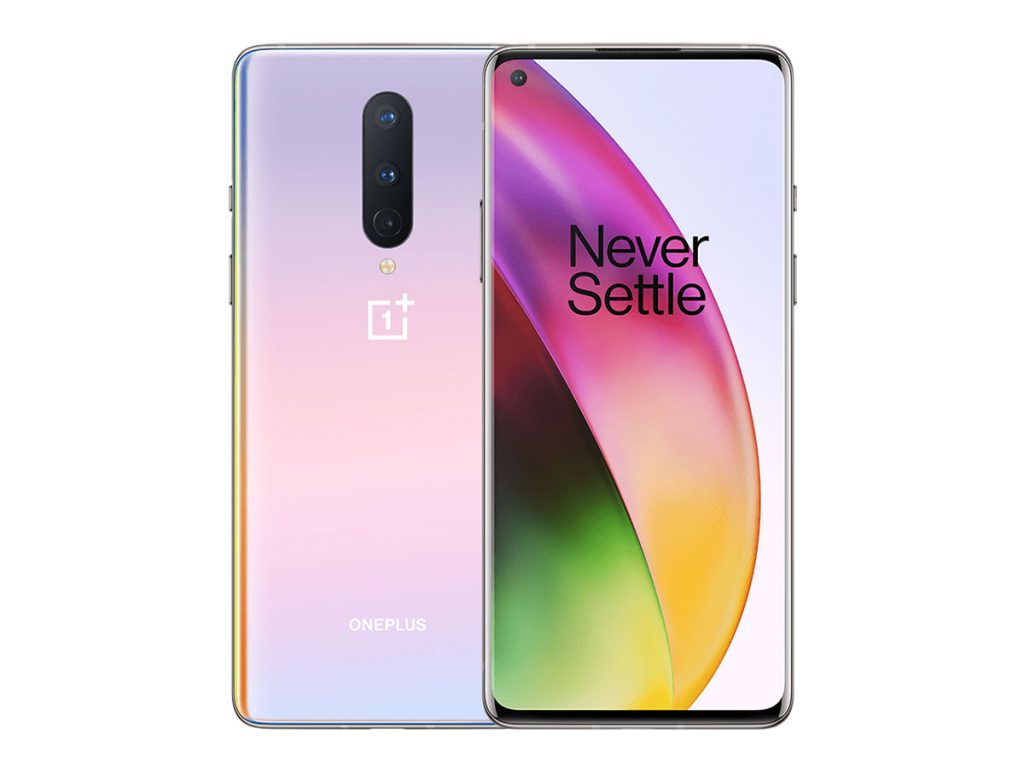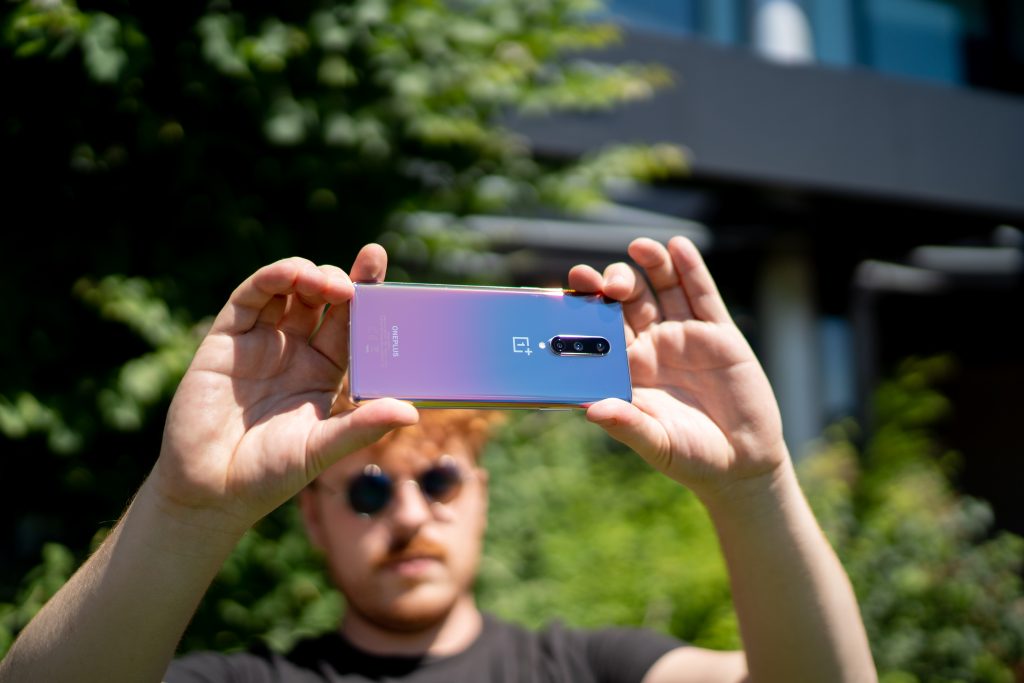The slightly smaller sibling of OnePlus’s new flagship 8 Pro, the OnePlus 8 still packs a lot of punch. Powered by a top-of-the-line Snapdragon 865 chipset and featuring a 6.55-inch AMOLED display with 90Hz refresh rate, it has almost the same specs as the Pro model. Both models come with either 8GB or 12GB of RAM and 128GB or 256GB of storage. The OnePlus 8’s triple main camera is impressive, although it doesn’t have the specialized fourth “color filter” camera module that the Pro version sports.
We put the OnePlus 8 through our rigorous DXOMARK Audio test suite to measure its performance both at recording sound using its built-in microphones, and at playing audio back through its one built-in speaker. In this review, we will break down how it fared in a variety of tests and several common use cases.
Key audio specifications include:
- Dual stereo speakers
- Noise cancellation
- Dolby Atmos support
About DXOMARK Audio tests: For scoring and analysis in our smartphone audio reviews, DXOMARK engineers perform a variety of objective tests and undertake more than 20 hours of perceptual evaluation under controlled lab conditions. This article highlights the most important results of our testing. Note that we evaluate both Playback and Recording using only the device’s built-in hardware and default apps. (For more details about our Playback protocol, click here; for more details about our Recording protocol, click here.)
Test summary


The OnePlus 8 achieved an overall Audio score of 68 in our testing — a surprising one point better than its bigger sibling, the OnePlus 8 Pro. This is partially due to a slightly better overall playback performance, but mostly thanks to dramatically different recording results. Specifically, the OnePlus 8’s Playback sub-score of 69 beat out the 8 Pro by a point, thanks to better sound dynamics and less audio artifacts. The OnePlus 8’s Recording sub-score of 66 led the 8 Pro by 3 points, largely due to a massive 16-point improvement in our Recording volume tests. Those improvements are somewhat offset by the fact that recordings on the OnePlus 8 have slightly more artifacts than the Pro version, and because there is a substantial reduction in the quality of background recordings.
The OnePlus 8’s Playback sub-score of 69 is anchored by relatively artifact-free sound. Tonal response is only average due to some weakness in the low end; as a result, the strong upper-midrange overpowers the lower-midrange, which means that voices and musical chords suffer. The dynamics of played-back sounds are generally good, although the phone’s issues with tonal range impair the punchiness of musical notes. In its favor, the OnePlus 8 has a nice, wide sound stage and good balance when playing back audio. Volume controls are also nicely linear when compared to its closest peer phones.
The OnePlus 8 ranks in between the 8 Pro and the Galaxy S20+ in our recording tests. Its audio Recording sub-score of 66 is three points above the 8 Pro and three points below the Galaxy S20+. Its tonal response is fairly good, and it does a particularly good job of accurately recording voices when using the main camera in most situations. However, when recording loud sound sources, an excess of bass impairs the listener’s ability to clearly hear voices and musical instruments.
Recordings made with the OnePlus 8 have very good sound dynamics, at least when using the main camera. Similarly, sound sources are relatively easily to localize when using the main camera, but not so much when using the front camera, which also features only mono recording. Unfortunately, the phone does not accurately preserve background sounds when recording.
Good spatial performance when playing back audio contributes to the OnePlus 8’s relative strength when used for gaming. However, quiet passages in classical music are hard to hear at the phone’s minimum volume setting.
For recording, the phone is best at recording memos and capturing videos with the main camera. Selfie video audio is lacking in several areas, including audible midrange resonances.
Sub-scores explained
The DXOMARK Audio overall score of 68 for the OnePlus 8 is derived from the Playback and Recording scores and their respective sub-scores. In this section, we will take a closer look at these audio quality sub-scores and explain what they mean for the user.
Playback
DXOMARK timbre tests measure how well a phone reproduces sound across the audible tonal range and takes into account bass, midrange, treble, tonal balance, and volume dependency.
The OnePlus 8’s tonal response is near the middle of the phones we have tested, matching that of the 8 Pro, despite having a relatively weak low-end response. High frequencies are well preserved, although there is a little too much emphasis on the upper midrange. This imbalance is most audible when the phone is set to playback at maximum volume. Unfortunately, lower midrange tones are somewhat neglected, which hurts the playback quality of voices and musical chords.
You can see how the lower-midrange doesn’t play back as strongly as the upper-midrange in this chart of the phones’s speaker frequency response:

Dynamics
OnePlus 8
66
81
Our dynamics tests measure how well a device reproduces the energy level of a sound source.
The OnePlus 8 has above-average sound dynamics on playback. In particular, notes have a strong attack, although at soft volumes this is somewhat impaired by the phone’s weak high-frequency response. The weak midrange tonal response we noted previously also impairs the phone’s punch. Perhaps surprisingly, bass tones feature good precision despite the phone’s lack of bass response. Its Playback dynamics sub-score of 66 is a point higher than that of the 8 Pro, and substantially above the 54 of the Samsung Galaxy S20+.

Spatial
OnePlus 8
67
88
The OnePlus 8 does a good job of spatially rendering sound sources, allowing listeners to effectively locate the direction of sound sources. It provides a nice, wide sound stage, which is particularly noticeable when gaming. But here, too, the weak lower-midrange has an effect, making it more difficult to estimate the distance of sound sources. Voices tend to sound farther away than they should, for example. Overall balance is good, although with a bit too much emphasis on elements in the center of the sound field.

Volume
OnePlus 8
69
91
Our volume tests measure both the overall loudness a device is able to produce and how smoothly volume increases and decreases based on user input.
The OnePlus 8 did well in our Playback volume tests, with its sub-score of 69 putting it three points ahead of its Pro sibling. In particular, it features good maximum volume. Our only real complaint is that at minimum volume settings, soft media such as certain passages of classical music can be hard to hear.
You can see in this chart that it maintains a more consistent volume response than the Galaxy S20+, and one very similar to the 8 Pro:
The OnePlus 8’s maximum volume is also decent, but below that of the 8 Pro. Here are sound pressure levels we measured when playing our sample recordings of hip-hop and classical music at maximum volume:
| Hip-Hop | Classical |
| 77 dBA | 72.5 dBA |

Artifacts
OnePlus 8
86
113
Our artifacts tests measure how much source audio is distorted when played back through a device’s speaker. Distortion can occur both because of sound processing in the device and because of the quality of the speakers.
Lack of artifacts when playing back audio is one of the strong points of the OnePlus 8’s performance in our tests. There is some noise, and some spectral artifacts, but not enough to keep it from getting a Playback artifacts sub-score of 86 — above almost every phone we have tested and two points above the 8 Pro (although still two points below the Galaxy S20+). It beat out the 8 Pro for less bass distortion at maximum volume, although some was still audible.
Recording

Timbre
OnePlus 8
76
91
The OnePlus 8 does a good job overall of preserving tonal balance when recording, particularly when recording videos with its main camera, and when recording memos. Voices sound natural and are free of resonance. Its Recording timbre sub-score of 76 is tied with the Galaxy S20+ and just a point below the 8 Pro. When recording videos with the front camera, however, there are a lot of resonances that detract from the sound, particularly midrange tones. As a result, voices tend to sound nasal and lack brilliance compared to when they are recorded with the main camera or with the memo app.
When recording loud audio sources, excessive bass not only impacts the tonal balance, but the relative lack of midrange and treble impair the recording of voices and the presence of musical instruments. This chart shows how the OnePlus 8 preserves tones across the frequency range when compared to the 8 Pro and the Galaxy S20+:

Dynamics
OnePlus 8
78
81
The dynamic elements of recorded sound are one of the highlights of the OnePlus 8’s audio performance. Even at high sound levels, speech envelopes are well preserved and instrument sounds are very punchy. As with tonal balance, videos recorded with the main camera on the OnePlus 8 have particularly good sound dynamics. The phone’s noise-canceling algorithms help it obtain a high signal-to-noise (SNR) ratio. However, noise canceling can be overdone when recording selfie videos. Overall, the OnePlus 8’s Recording dynamics sub-score of 78 is the highest of any device we have tested. For reference, that’s 10 points above the Galaxy S20+, and 16 points above the 8 Pro.

Spatial
OnePlus 8
52
78
Recordings made with the OnePlus 8’s main camera have reasonably good spatial reproduction. It is easy to locate voices when recording video with the main camera, thanks in part to good tonal balance of speech content, and to a wide sound stage. In comparison, selfie videos suffer spatially because of mono recording. Similarly, the distance of sound sources is relatively easy to pinpoint in videos made with the main camera, but limited when listening to selfie videos because of poor tonal balance in the front camera recording app.

Volume
OnePlus 8
58
99
The volume levels of recordings made with the OnePlus 8 are fairly good, including voice levels, which gives the phone a decent Recording volume sub-score of 58. While this is at the lower end of the devices we’ve tested, and 8 points below that of the Galaxy S20+, it’s an impressive 16 points above that of its larger sibling, the 8 Pro.
This chart shows the loudness of our recording test samples, measured in LUFS (Loudness Unit Full Scale). As a reference, we expect loudness levels to be above -24 LUFS for recorded content. The OnePlus 8 records at a usable level in most of our use cases, although the meeting scenario levels are a little low:
| Meeting | Life Video | Selfie Video | Memo |
| -25.3 LUFS | -20.5 LUFS | -17.2 LUFS | -19.9 LUFS |

Artifacts
OnePlus 8
67
97
The OnePlus 8 does a fairly good job of keeping artifacts out of recordings. There is some distortion and pumping, especially in videos recorded with the main camera, and this is particularly pronounced when recording loud sound sources. The phone does a good job of dealing with finger occlusion when held in landscape mode when using the main camera to record video. However, the microphones can be completely occluded when recording selfie videos.

Background
OnePlus 8
31
60
The OnePlus 8 does a below-average job of preserving the fidelity of background sounds during recording. Audible distortion and volume pumping occur when recording loud sound sources, especially when recording video with the main camera. Its weakness in this area shows up clearly, as its Recording background sub-score of 31 is 13 points below that of the 8 Pro and 19 points below the Galaxy S20+.

Conclusion
The OnePlus 8 does an above-average job of handling audio compared to the devices we’ve tested. In particular, its recording performance is well above that of the 8 Pro and the Galaxy S20+, the two phones we most closely compared it with. Its wide sound stage is helpful for providing immersive audio experiences. Overall it performs comparably to other value-priced flagship phones, although it isn’t in our top bracket of audio performers.
One area worth noting in particular is that the OnePlus 8 is our category leader when it comes to artifact-free recording, making clean sound one of its hallmarks. However, there is a fairly large disparity between its performance when recording with the main camera versus recording with the front camera, so video bloggers might not find the OnePlus 8 ideal for their work.
Playback
Pros
- Good spatial performance due to accurate audio source localizability
- Good dynamics despite timbre performance
- Good maximum volume playback
Cons
- Timbre performance, especially voices and chords, are impaired by a lack of low midrange and low-end extensions at low volume
- Minimum volume is too low, as soft content such as classical music is barely audible
- Some distortion (mostly bass) is noticeable and impairs overall experience
Recording
Pros
- Overall good timbre performance in life video and memo use cases
- Very good localizability and wideness in life video, thanks to good tonal reproduction
- Excellent dynamics performance, especially with loud audio sources
- Good volume performance
Cons
- Due to mono recording performance, video spatial experience is impaired
- Video recordings tend to add a lot of midrange resonances, resulting in voices that tend to sound nasal compared to other use cases
- Artifacts such as distortion and pumping impair overall experience
- When recording loud sources, bass prominence impacts tonal balance, decreasing voice and instrument presence









DXOMARK encourages its readers to share comments on the articles. To read or post comments, Disqus cookies are required. Change your Cookies Preferences and read more about our Comment Policy.